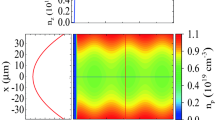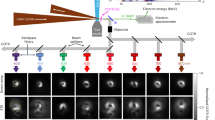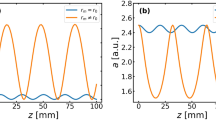Abstract
Ultrashort light pulses are powerful tools for time-resolved studies of molecular and atomic dynamics1. They arise in the visible and infrared range from femtosecond lasers2, and at shorter wavelengths, in the ultraviolet and X-ray range, from synchrotron sources3 and free-electron lasers4. Recent progress in laser wakefield accelerators has resulted in electron beams with energies from tens of mega-electron volts (refs 5,6,7) to more than 1 GeV within a few centimetres8, with pulse durations predicted to be several femtoseconds9. The enormous progress in improving beam quality and stability5,6,7,8,10 makes them serious candidates for driving the next generation of ultracompact light sources11. Here, we demonstrate the first successful combination of a laser-plasma wakefield accelerator, producing 55–75 MeV electron bunches, with an undulator to generate visible synchrotron radiation. By demonstrating the wavelength scaling with energy, and narrow-bandwidth spectra, we show the potential for ultracompact and versatile laser-based radiation sources from the infrared to X-ray energies.
This is a preview of subscription content, access via your institution
Access options
Subscribe to this journal
Receive 12 print issues and online access
$259.00 per year
only $21.58 per issue
Buy this article
- Purchase on SpringerLink
- Instant access to full article PDF
Prices may be subject to local taxes which are calculated during checkout



Similar content being viewed by others
References
Zewail, A. Nobel 47 Lecture (1999) 274–367 (Nobel Lectures in Chemistry 1996–2000, World Scientific, Singapore, 2003).
Squier, J., Salin, F., Mourou, G. & Harter, D. 100-fs pulse generation and amplification in Ti:Al2O3 . Opt. Lett. 16, 324–326 (1991).
Bilderback, D. H., Elleaume, P. & Weckert, E. Review of third and next generation synchrotron light sources. J. Phys. B 38, S773–S797 (2005).
Ayvazyan, V. et al. First operation of a free-electron laser generating GW power radiation at 32 nm wavelength. Eur. Phys. J. D 37, 297–303 (2006).
Mangles, S. P. D. et al. Monoenergetic beams of relativistic electrons from intense laser plasma interactions. Nature 431, 535–538 (2004).
Geddes, C. G. R. et al. High quality electron beams from a laser wakefield accelerator using plasma-channel guiding. Nature 431, 538–541 (2004).
Faure, J. et al. A laser-plasma accelerator producing monoenergetic electron beams. Nature 431, 541–544 (2004).
Leemans, W. P. et al. GeV electron beams from a centimetre-scale accelerator. Nature Phys. 2, 696–699 (2006).
Pukhov, A. & Meyer-ter Vehn, J. Laser wake field acceleration: The highly non-linear broken-wave regime. Appl. Phys. B 74, 355–361 (2002).
Faure, J. et al. Controlled injection and acceleration of electrons in plasma wakefields by colliding laser pulses. Nature 444, 737 (2006).
Jaroszynski, D. A. et al. Radiation sources based on laser-plasma interactions. Phil. Trans. R. Soc. A 364, 689 (2006).
Chapman, H. et al. Femtosecond diffractive imaging with a soft-X-ray free-electron laser. Nature Phys. 2, 839–843 (2006).
Tajima, T. & Dawson, J. M. Laser electron accelerator. Phys. Rev. Lett. 43, 267 (1979).
Pittman, M. et al. Design and characterization of a near-diffraction-limited femtosecond 100-TW 10-Hz high-intensity laser system. Appl. Phys. B 74, 529–535 (2002).
Schwoerer, H. et al. Thomson-backscattered x rays from laser-accelerated electrons. Phys. Rev. Lett. 96, 014802 (2006).
Hidding, B. et al. Generation of quasimonoenergetic electron bunches with 80-fs laser pulses. Phys. Rev. Lett. 96, 105004 (2006).
Jackson, J. D. Classical Electrodynamics (Wiley, New York, 1975).
Tanaka, T. & Kitamura, H. SPECTRA: A synchrotron radiation calculation code. J. Synchrotron Radiat. 8, 1221 (2001).
van Tilborg, J. et al. Temporal characterization of femtosecond laser-plasma-accelerated electron bunches using terahertz radiation. Phys. Rev. Lett. 96, 014801 (2006).
Glinec, Y. et al. Observation of fine structures in laser-driven electron beams using coherent transition radiation. Phys. Rev. Lett. 98, 194801 (2007).
Jaroszynski, D. A. et al. Superradiance in a short-pulse free-electron-laser oscillator. Phys. Rev. Lett. 78, 1699–1702 (1997).
Rousse, A. et al. Production of a keV X-ray beam from synchrotron radiation in relativistic laser-plasma interaction. Phys. Rev. Lett. 93, 135005 (2004).
Phuoc, K. T. et al. Imaging electron trajectories in a laser-wakefield cavity using betatron X-ray radiation. Phys. Rev. Lett. 97, 225002 (2006).
Schwoerer, H. et al. Laser–plasma acceleration of quasi-monoenergetic protons from microstructured targets. Nature 439, 445–448 (2006).
Hegelich, M. et al. Laser acceleration of quasi-monoenergetic MeV ion beams. Nature 439, 441–444 (2006).
Glinec, Y. et al. Absolute calibration for a broad range single shot electron spectrometer. Rev. Sci. Instrum. 77, 103301 (2006).
Tanaka, K. A. et al. Calibration of imaging plate for high energy electron spectrometer. Rev. Sci. Instrum. 76, 013507 (2005).
Acknowledgements
This work was supported by the Deutsche Forschungsgemeinschaft under contract TR18. Financial support by the Access to Research Infrastructures activity in the Sixth Framework Programme of the EU (contract RII3-CT-2003-506350, Laserlab Europe) for conducting the research is gratefully acknowledged. We thank B. Beleites, F. Ronneberger and W. Ziegler for their technical support. S.M.W. acknowledges the support of the Department of Physics, Lancaster University, and the Cockcroft Institute, Daresbury Laboratory, Daresbury, UK. The UK team also acknowledges the support of the 105 Research Councils UK, EPSRC and the EU EuroLEAP NEST contract no. 028514.
Author information
Authors and Affiliations
Corresponding author
Rights and permissions
About this article
Cite this article
Schlenvoigt, HP., Haupt, K., Debus, A. et al. A compact synchrotron radiation source driven by a laser-plasma wakefield accelerator. Nature Phys 4, 130–133 (2008). https://doi.org/10.1038/nphys811
Received:
Accepted:
Published:
Issue date:
DOI: https://doi.org/10.1038/nphys811
This article is cited by
-
Attosecond-Angstrom free-electron-laser towards the cold beam limit
Nature Communications (2023)
-
Femtosecond electron microscopy of relativistic electron bunches
Light: Science & Applications (2023)
-
A beamline to control longitudinal phase space whilst transporting laser wakefield accelerated electrons to an undulator
Scientific Reports (2023)
-
Seeded free-electron laser driven by a compact laser plasma accelerator
Nature Photonics (2023)
-
Propagation of intense laser pulses in plasma with a prepared phase-space distribution
Scientific Reports (2022)



